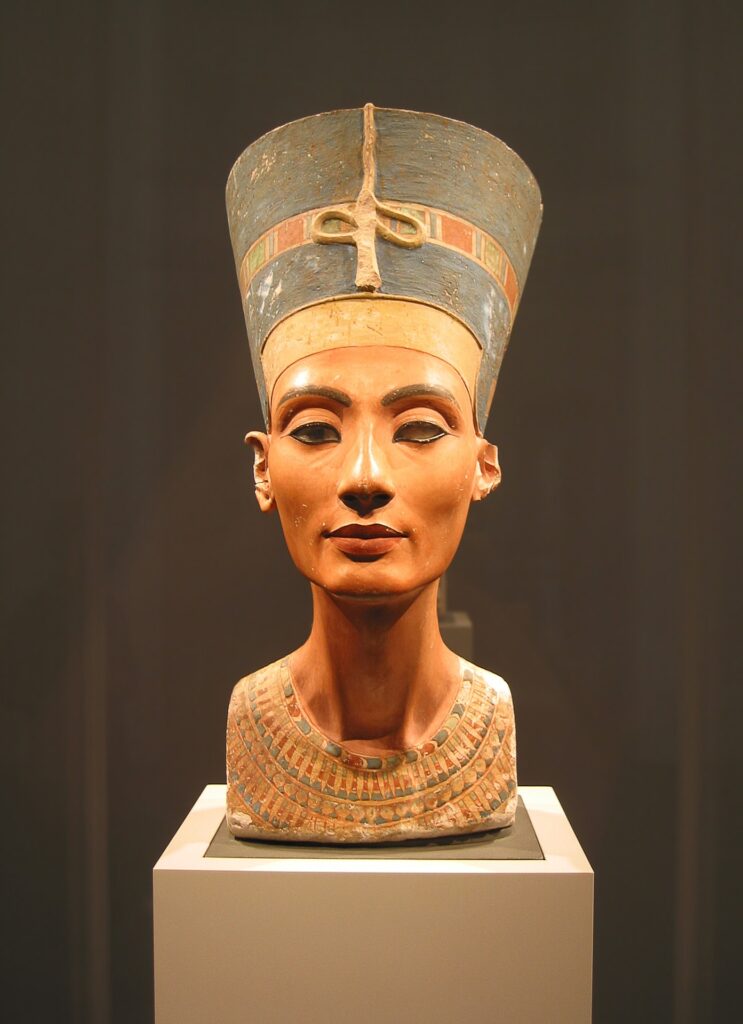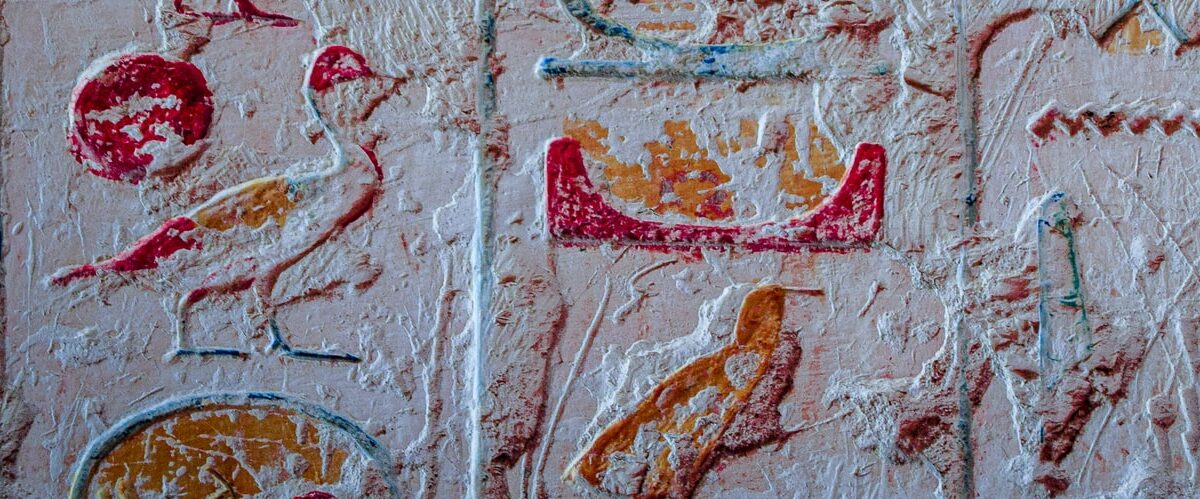From spiritual rulers to warrior queens, women have an important legacy of strong and influential leadership in Africa. While much is known of the male leaders, the lives of influential women and the legacies they leave behind is often less well understood. Over recent decades, museums, writers and archaeologists are revisiting the lives of influential women rulers to rediscover more about their lives.
Fragments of Nefertiti
Nefertiti is one of the most widely recognised queens of African antiquity. This is largely because of a beautiful bust of her ‘discovered’ by German archaeologist in 1912. The bust currently sits in a Berlin museum and has captivated generations of history lovers who yearn to know more. Actual details about Nefertiti’s reign as queen can only be found in fragments of iconography and religious art. If her tomb is rediscovered, we may learn more, but what we do know from archaeological evidence points to a woman with significant power for her time. Nefertiti ruled Egypt, alongside her husband Akhenaten in the 14th century BCE and presided over a tumultuous period of religious, cultural and political reform.

Nefertiti the disruptor queen
Nefertiti was the chief wife of the controversial reformist Pharaoh Akhenaten. Shortly after taking the throne, Nefertiti and Akhenaten completely transformed ancient Egyptian society by introducing a new monotheistic religion focused on the sun god, Aten. The decision to reject and replace the ancient Egyptian pantheon of gods would have rocked Egyptian society and likely caused tensions between the ruling family and the established elite. Nefertiti and Akhenaten’s controversial 17 year reign would come to be known as the Amarna period.
In the fifth year of the Amarna period, Nefertiti and Akhenaten established a brand new city which they named Akhetaten – Horizon of the Aten. This meant that both the religious and political seat of power shifted from the ancient Egyptian city of Thebes to newly-built Akhetaten, where the new religion could flourish. Egyptologists presume this caused immense upheaval in Egyptian society.
The city was dedicated to the worship of the sun and the royal couple were the chief spiritual mediums through which the word of Aten could be heard by the people. Iconography from this time depicts Nefertiti with her family basking in the rays of the new sun god, demonstrating her spiritual influence at the time.
Royal women during the Amarna period
Archaeological evidence provides us with a number of examples of women rulers in Ancient Egypt, however, during the Amarna period, it appears that Neferiti enjoyed particular influence. Nefertiti features in many pieces of art and iconography during this time, one image famously showing her sitting opposite her husband, bouncing her daughter on her knee. The fact that Nefertiti’s image is roughly the same size as Akhenaten’s, likely demonstrates that she was viewed as equal to her husband. It may be that Nefertiti was used to promote and legitimise the new religion of the sun god by acting as the spiritual conduit for women and girls. Artefacts from the Amarna period suggest that she could have been viewed as a living goddess, a title usually only reserved for queens who had passed.

A powerful queen
Nefertiti was not only powerful in her role as wife and queen to Akhenaten but also powerful in her own right. Archaeological evidence suggests that Nefertiti may have ruled following the death of her husband for a number of years, however, Egyptologists are not certain on this hypothesis. She was succeeded by the very young Tutankamun, who was most probably Akhenaten’s son by another wife.
After Akhenaten’s death, Nefertiti likely unsuccessfully tried to continue to support the new religion. Archaeologists believe that the old Egyptian pantheon and political structures were quickly restored following Nefertiti and Akhenaten’s reign and their new city of Akhetaten was quickly abandoned. Images of the couple and references to the god Aten were also removed from stonework and art. This suggests that the controversial reforms the royal couple had enacted were not broadly accepted by Egyptian society.
A mysterious legacy
Much of Nefertiti’s life remains a mystery due to the limited archaeological evidence about her time as ruler, but what we do know suggests she was an incredibly influential woman. This is likely due to her status as chief wife, as a living goddess and her attachment to the new sun religion. Perhaps it is the mystery surrounding her life that ensures her legacy lives on to this day.
We get a glimpse of what life was like during Nefertiti’s reign through archaeological materials such as the sprawling ruins of Akhetaten, now known as Tell el-Amarna. Today this is a longstanding archaeological project and one of the best preserved ancient cities in Egypt. We also have the Amarna Letters, which outline what relations were like between Egypt and neighbouring kingdoms during Nefertiti’s time as queen. These are incredibly important materials in the quest to understand this period better.
Nefertiti has captured the attention of many scholars and journalists eager to tell her story. Her status as one of only a few prominent ancient Egyptian queens makes her an intriguing figure and there is a lot of interest in discovering more about her rise to power and why she became so notable. Until archaeologists uncover more material about her life, lovers of history must speculate.
Queen Amina of Zaria
Fast forward hundreds of years to pre-colonial West Africa, now modern day Nigeria. Here we are introduced to the military strategist and warrior, Queen Amina. She was ruler of the Hausa people in territory called Zazzau that is now part of the Kaduna state of Nigeria. Born around 1533 CE, she was the daughter of another famous ruler, Queen Bakwa Turunku, who is credited with founding the city of Zaria along with her husband. This city is still famous for its beautiful, richly decorated mud walls. Amina had a powerful role-model of female leadership in her mother. The achievements she made over the course of her reign as queen make her one of the most celebrated rulers in West African history to this day.
From a young age, Amina showed an interest in learning military skills and strategies and over the course of her youth, she accumulated numerous victories, earning the trust and respect of fellow warriors. As a young woman, she rose to lead the kingdom’s cavalry and according to oral and written histories, was formidable in battle. Following her brother’s early death after only 10 years on the throne, Amina officially became queen.
Military and markets
Queen Amina is responsible for the vast expansion of Zazzou territory and strengthening of the kingdom’s economy over the course of her reign. During the 34 years of rule, Amina led numerous military campaigns with neighbouring powers, slowly and steadily acquiring new land. While she is remembered for her military prowess, it is likely that her time as queen was characterised by a long series of battles.
However, Amina’s rule not only expanded territory but supported the growth of trade and commerce. Each time the kingdom of Zazzau grew larger, it became easier and safer for Hausa traders to move freely across greater distances.
Amina fostered new industries in her Kingdom such as new crops like kola trees so that the kola nuts could be traded across West Africa and beyond through important cities like Zaria, bringing wealth and prosperity. Kola nuts (where Coca-Cola got its name) are chewed to release the caffeine inside and have long been used as stimulants. They were consumed all across West Africa in pre-colonial times and later by Europeans.
Trade and commerce
Hausa traders who were more mobile as a result of the quickly expanding kingdom and Hausa products could reach into new markets. This allowed commerce to thrive and encouraged craftspeople to innovate and develop new products and services.
Many new strategic trade routes were established throughout Amina’s kingdom that gave her people economic advantages. During her reign, the city of Zaria grew in importance as a premier trading hub in the region. The city was lucky to be strategically located between the Sahara and the southern coast, meaning that not only was the Hausa kingdom producing more products but also offered foreign traders safe passage to transport their goods.
Queen Amina’s military prowess earned her immense respect among her people. But it was not only her leadership in battle but also her ability to build a prosperous society, one built on artisan skill and entrepreneurial spirit, that remains one of her greatest achievements.

Amina’s legacy
Queen Amina of Zaria lives on in history books and through the oral traditions of modern day Nigeria, but she also has a prominent place in pop culture. Amina’s reign is immortalised through film, most famously captured in the Nollywood movie Amina, Queen of Zazzau. She can also be found in children’s literature and has inspired many books. She is even featured in comic books and stories, where her life and achievement inspire young and old. Perhaps most famously, Amina’s life is the inspiration for the fictional character of Xena, warrior princess.
Amina’s rule took place in pre-colonial times, highlighting how Hausa society did not preclude women from becoming powerful leaders but rather celebrated them. In many ways, Amina’s story rejects common stereotypes about the role of women in pre-colonial Africa, providing us with an alternative narrative about strength, intelligence and respect.
Telling their stories
Nefertiti and Amina are two of many exceptional leaders and influential women who left lasting legacies in Africa and beyond. They lived in vastly different times, but both women presided over periods of significant societal change. Nefertiti ruled during substantial religious reform and Amina expanded her kingdom, bringing with it immense wealth.
While history tells many stories of kings and men, women held power and influence that shaped the lives of their people. They leave lasting legacies, whether that be through the archaeological record or through oral histories and pop culture. Let’s celebrate them.
Header photo by Tom Podmore on Unsplash





